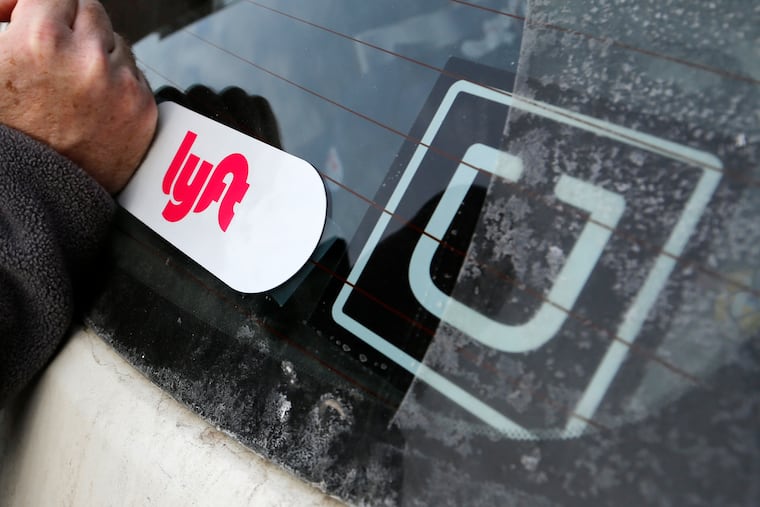Lyft: In top markets, Philly claims highest percentage of rides that start or end in low-income areas
The report from the rideshare company shows who's driving and riding, but also how it's working with public transportation.

The percentage of Lyft rides that start or end in low-income neighborhoods is greater in Philadelphia than nearly anywhere else in the U.S., according to a report from the rideshare company that sheds light on how the service is working in the region.
The 60% in Philly is highest among its top U.S. markets — Atlanta, New York City, Boston, Chicago, Washington, Los Angeles, Miami, San Francisco — and looms above 40% nationally, according to Lyft.
But it’s not the highest overall. Buffalo; Cincinnati; Lansing, Mich., and Richmond, Va., all had larger proportions of rides start or end in low-income areas than Philadelphia, according to Lyft’s 2020 Economic Impact Report, released in February.
Philadelphia is the poorest of the 10 most populous U.S. cities. That fact, plus initiatives that Lyft launched in Philly last year aimed to improve grocery and job access, may have contributed to the city’s ranking, said Josh Huber, general manager of Pennsylvania for Lyft.
Huber also pointed to affordability. Depending on how often a rider uses it, ridesharing can make more sense than owning a car.
“It’s not super surprising to see how we might see a higher ridership in some of those lower-income areas," Huber said.
The company didn’t point to specific neighborhoods but defined “low-income” areas using federal data.
The report also covers who is driving and who is riding, impact on car ownership, and the relationship between ridesharing and public transportation across the U.S. The national findings come from an online questionnaire completed by about 74,700 drivers and about 33,400 riders between Oct. 23 and Nov. 11 last year as well as Lyft’s own internal figures. Uber could not provide comparative data.
Ridesharing services have been around for years, but there are still questions to be answered, said Brett Fusco, manager at the office of long-range planning at the Delaware Valley Regional Planning Commission.
“Public and private markets are still trying to feel each other out and trying to understand where each is coming from, so what I like about the report is it says a lot of the right things," Fusco said. “They’re definitely paying a lot of attention to the bigger challenges that we’re facing and looking to help address them.”
Car ownership
Lyft’s report suggests ridesharing has curbed car usage in Philadelphia, with 38% of riders who don’t own or lease their own car, with 50% without access to a car claiming they’d be more likely to buy one if it weren’t for Lyft. Sixty-one percent who do have access to a car say they use the car less because of the service — 46% said so nationally.
But it’s impossible to talk about ridesharing without talking about congestion — something Huber said is “complex and impossible to pinpoint to one, single reason alone.”
» READ MORE: Cities around the world have figured out how to ease congestion. Here are five fixes for Philly.
Rideshare companies may intend to ease congestion, but pickups and dropoffs are a sore spot, Fusco said. If a driver blocks a lane, it slows traffic for everyone.
“There’s a lot of competition for curb space right now,” Fusco said.
The city knows the issue all too well, supporting reforms for ridesharing services as well as managing curbside and parking in its 2018 Connect plan. Philadelphia is tackling congestion in other ways, such as through a loading-zone pilot program along Chestnut Street, and a plan to add traffic enforcement officers.
A relationship with SEPTA
Lyft knows it is not riders’ only option.
Its 2020 Economic Report for Philadelphia says 56% of riders have used a Lyft service to get to or from public transportation, and 55% use Lyft when public transit doesn’t run.
Although it’s not available in Philly, Lyft has a feature in some cities that shows public transportation options close by. Uber has a similar feature available, while Google Maps moved in a similar direction in August.
Fusco said he welcomes options.
“From a public transportation perspective, we want to make sure at the same time that transit remains a strong, integral part of our transportation network,” Fusco said. "So we think those partnerships are really key.”
The Philadelphia Inquirer is one of 21 news organizations producing Broke in Philly, a collaborative reporting project on solutions to poverty and the city’s push toward economic justice. See all of our reporting at brokeinphilly.org.